The Australian Government gives all citizens access to a high standard of health care. The major part of the national health care system is called Medicare. Medicare ensures that all Australians have access to free or low-cost medical, optometrical (офтальмологический) and hospital care while being free to choose private health services. Australia’s public hospital system is jointly funded by the Australian Government and state and territory governments and is administered by state and territory health departments.
State and Territory governments have primary responsibility for operating hospitals, school, dental, maternal and child health programs, occupational health and safety services (производственная медицина), disease control, and health inspections.
Australian boys born between 1994 and 1996 can expect to live for about 75 years, and girls born in the same period for 81 years.
HealthInsite
Australians can now access quality health information on the Internet through HealthInsite – a new web site that has been developed by the federal Department of Health and Aged Care.

HealthInsite is a single gateway to credible information on a broad range of health issues. Comprehensive information on topics such as cancer, diabetes, kidney disease, child health, stroke and heart disease can all be found on the site. This information is provided from leading health information providers from the public and private sectors.
Doctors in chains
All three candidates for the title of Australia’s first doctor were convicted felons. John Irving, transported for larceny (воровство), became assistant to the naval surgeons of the First Fleet. He was the first convict to be freed, in 1790, and did fine work at the General Hospital until he died five years later.
William Redfern, transported in 1801 for taking part in a naval mutiny (мятеж), was the first to practise privately. His skills soon gained him a pardon and on 1 September 1808 he was granted Australia’s first medical certificate. Redfern did much to improve hygiene in the colony, and he also fought successfully for full civil and legal rights for former convicts.
Australia’s first, full-time, general practitioner was William Bland, who had been transported for killing an opponent in a duel. He set up practice when he was pardoned in 1815.
Rum hospital
Among the first temporary shelters to be erected on the shores of Sydney Cove within days of the First Fleet’s arrival in January 1788 were hospital tents. Although first fleeters had remained remarkably healthy throughout the voyage, the tents were soon filled with people suffering from scurvy (цынга) and dysentery.
In 1811, in exchange for the right to import 45 000 gallons of ‘rum’ (which meant all kinds of spirits), three entrepreneurs – Garnham Blaxcell, Alexander Riley and D’arcy Wentworth (the Principal Surgeon) – contracted (подрядились) to build a three-block hospital in Sydney. The building was completed in April 1816, but for its first three years the hospital had no inside lavatories and often patients could be seen crawling to outside privies (туалет).

Three-blocked “Rum hospital”, 1816
The ‘Rum Hospital’ was always far too big for the colony, and so in 1829 its north wing became Parliament House. The central building was torn down in 1879 to make way for the present Sydney Hospital and the south wing, used as a mint (монетный двор) from 1855 to 1926, is now a museum.

Bicentenary of convict hospital (“Rum hospital”), 2016
Epidemic
Many epidemics have swept Australia during the past 200 years (including bubonic plague, small-pox, chickenpox, measles, Asiatic flu and scarlet fever) but by far the most serious was the influenza epidemic of 1918–19. The disease, which devastated the world during these years, arrived in Melbourne in January 1919, probably brought by soldiers returning from World War I. Forewarned by the terrible toll (жертвы) on the other side of the world, the authorities promptly brought in regulations. It became compulsory for everyone to wear in public a gauze (марлевая) mask. Schools, churches, racecourses, libraries and many hotels were closed.
New South Wales drinkers were luckier than most since their pubs stayed open, although patrons (завсегдатаи) had to drink quickly because they could spend only five minutes at the bar. Victims’ houses were quarantined for four days, during which time no one who lived there could leave. Quarantine camps were set up in cities all over Australia and travellers had to wait a week in camps at state borders for any symptoms to appear. 10263 died during the epidemic.
Royal Flying Doctor Service of Australia

The Royal Flying Doctor Service of Australia (RFDS, informally known as The Flying Doctors) is an air ambulance service for those living in the remote inland areas of Australia. It is a not-for-profit organization which provides both emergency assistance and primary health care to people who cannot easily access a hospital due to the prohibitive distances of the outback (необжитая местность).
While Aborigines had learned to survive the arid (засушливый) interior of the Australian continent, European immigrants found the isolation hard to bear. Giant pastoral ranches of thousands of square miles meant women and children often had no outside human contact for months at a time.
In the early years, one of the biggest worries of people in the outback was becoming ill. It was not until the appearance of a clergyman named John Flynn (1880 –1951) that some form of medical service became available to people in remote areas of the country. Flynn’s missionary work involved the establishment of hospitals in bush communities. This, however, did not help those who lived far from any major community. In his public speaking he would often retell the tragic circumstances that had befallen (случаться) bush settlers.

John Flynn
On one occasion a ranch hand (работник) with a spear embedded (вонзить) in his chest was carried in a hammock slung (подвешенный) between horses to Oodnadatta, 640 kilometers away. There he waited for two weeks for a train to take him 970 kilometers to a hospital in Adelaide.
One of the world’s most unusual operations was performed at the remote Western Australian settlement of Halls Creek on 28 July 1917. Jimmy Darcy was a stockman (ковбой) in Western Australia. After being found injured by some friends, he was transported over 30 miles (12 hours), to the nearest town, Halls Creek. Here, Darcy was met by F.W. Tuckett, the Postmaster, and the only man in the settlement trained in first aid. Tuckett said there was nothing he could do for injuries so serious, and tried unsuccessfully to contact doctors at Wyndham, and then Derby, by telegraph. He eventually got through to Dr Holland, who sat nearly 4000 kilometres away at the end of a telegraph wire in Perth. Through communication by Morse code, Dr Holland guided Tuckett through two operations utilising the only sharp instrument available, a pen knife. Every instruction and question had to be laboriously transmitted in Morse code, from operator to operator. It took Tuckett seven hours to complete the operations.
Then Dr Holland travelled 10 days to Halls Creek on a boat for cattle transport, a Model T Ford (первая модель Форда), a horse drawn carriage (повозка), and even on foot. When he arrived he found that although the operations were successful, Darcy, weakened by undiagnosed malaria and an abscessed appendix, had died the day before.
The tragedy elbowed (потеснила) even war news from many Australian newspapers and more than any other single event attracted nationwide attention to the urgent need for doctors, hospitals and nurses in outback Australia.
Flight and Radio: The fusion of two fledgling technologies
Victorian Lieutenant Clifford Peel had heard Flynn’s public speeches and sent Flynn a letter explaining how he had seen a missionary doctor visiting isolated patients utilising a plane. Flynn immediately published Peel’s idea in the church’s newsletter. Sadly Peel died in combat in France in 1918, probably not even knowing the impact he had in the creation of an Australian icon.
Along with aviation, another new technology was being developed that could replace the complicated means of communication by telegraph. Together with a brilliant young engineer Alfred Traeger (1895 – 1980), Flynn began experiments with radio in the mid 1920s to enable remote outposts (отдаленное поселение) to contact a centralized medical base.
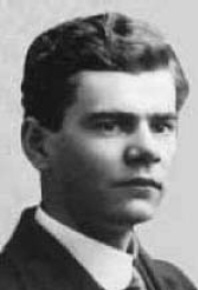
Alfred Traeger
The result of this collaboration was the pedal-driven Morse radio transmitter and receiver -transceiver – (радиопередатчик и приемник, использующий азбуку Морзе и питаемый электричеством, вырабатываемым кручением педалей) with a range of 300 miles, which most homesteads (ферма) could afford. The pedal outfit provided complete communication for the isolated homestead.

Transceiver Set #1, 1930
In 1907 a quiet Australian farm boy astonished his family by building a telephone between the homestead and a machinery barn 50 yards away. He had no commercial equipment – the magnets were made from pitch fork prongs (зубья вил), the diaphragms from tobacco tin lids (крышки от коробочек табака), and the charcoal (древесный уголь) for carbon granules came from the kitchen stove. The farm fencing wire was also called into service. The boy's name was Alfred Traeger, and a shrewd father soon had him enrolled in an electrical engineering course.
Traeger and Flynn traveled along the country installing the two-way radios and showing settlers how to use them to call mission headquarters. The transceiver, with the use of airplanes, made possible a system of regular long-distance medical consultations and the flying of doctors to patients in emergencies.
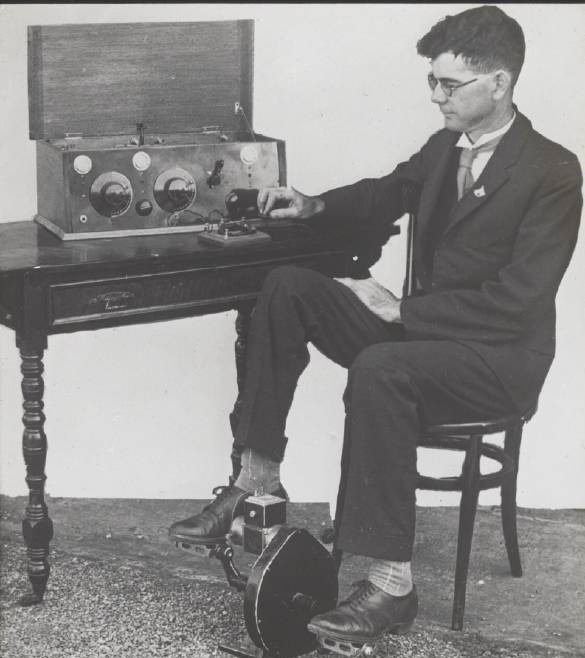
Alfred Traeger is at work

Mrs. Gertrude Rothery operates the first pedal radio on June 19, 1929
By 1928, Flynn had gathered sufficient funds through fundraising (сбор пожертвований) activities to launch an experiment known as the Aerial Medical Service (AMS) which was to run for a single year. This experiment was based in Cloncurry, Queensland.
Its supporters included industrialist H.V. McKay, medical doctor George Simpson, and Hudson Fysh, one of the founders of Queensland and Northern Territory Air Service, the company which would go on to become QANTAS (сейчас – национальная авиакомпания Австралии). QANTAS supplied the first aircraft to the new organisation, a De Havilland model DH50, dubbed “Victory”. QANTAS charged two shillings per mile for use of the Victory during the first year of the project.
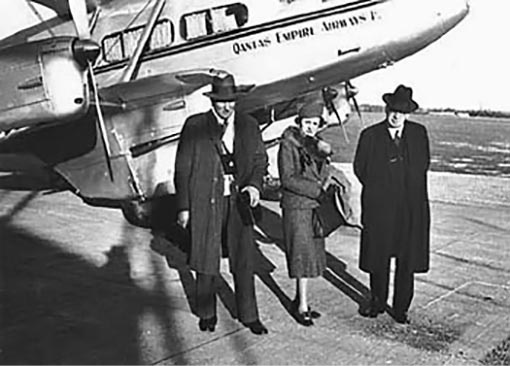
Dr George Simpson (left), his wife Nesta and John Flynn, 1950
On 15 May 1928 pilot Arthur Affleck, accompanied by Dr Kenyon Welch, made his first “Aerial Medical Service” trip to Julia Creek, 134 km away. They flew in an open cockpit (кабина пилота), single engine biplane, “Victory”. In the first year, pilot Arthur Affleck and Dr Kenyon Welch flew 28 129 kilometres to attend 255 patients.
The first Flying Doctor pilot, Arthur Affleck, had no navigational aids, no radio and only a compass and inadequate maps, if any. He navigated by landmarks such as fences, rivers, river beds, dirt roads or just wheel tracks and telegraph lines. He also flew in an open cockpit, fully exposed to the weather, behind the doctor’s cabin.
John Flynn finally retired and died in 1951 in Sydney, and was cremated and his remains placed under a large boulder (камень, валун) from the Devil’s Marbles. Unfortunately, the Northern Territory Department of Public Works had taken the rock from a site sacred to its Aboriginal owners. After many years of negotiations the rock was returned to its original location in 1998 and replaced with one acceptable to the Aboriginal people. John Flynn is buried at Mt Gillen near Alice Springs, the very centre of the vast territory to which he brought communication, medical comfort and pastoral care.
Flynn received an Order of the British Empire in 1933. He is featured on one side of the current Australian 20 dollar polymer note.

John Flynn pioneered the world’s first aerial medical service
Success, and continued success

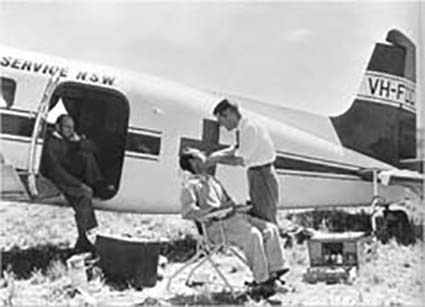
Australian Aerial Medical Service
In 1932, the success from its operations in Cloncurry, and the increasing public awareness to this vital rural service, resulted in a push for a national network of flying doctors, hopefully with sponsorship from the government. In 1934, this was realized with the new Australian Aerial Medical Service opening up “Sections” across the nation.
In 1942 it was renamed to Royal Flying Doctor Service.
Until the 1960s the service predominantly hired aircrafts, pilots and service technicians from contractors. After this point, the service moved on to purchasing its own equipment and employing its own pilot and mechanics.
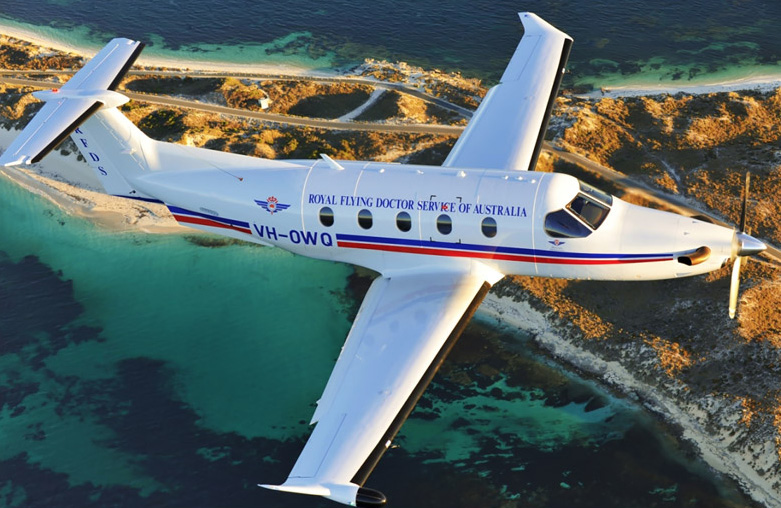
The new name of the medical service RFDS
The service became the first comprehensive air ambulance service in the world. During its first few decades the service relied heavily on community fundraising, volunteer support and donations. This is still the mainstay (основа) of the services funding, but it benefits greatly from State and Federal Government subsidiaries that have since been introduced.
The service today
Today, 80% of emergency evacuations are performed with only a nurse and pilot being present in person, a doctor directing such actions from a remote location.
The service basically holds true to the original model set by John Flynn. Its services include:
● On site emergency first aid;
● Radio advice to remote situations ( although most communication these days is by mobile phone);
● Transportation of a general practitioner for regular clinical visits to remote areas;
● Consultation, communication and support for rural and remote doctors across Australia;
● Inter-hospital transfer of patients.
In their spare time from urgent calls, doctors do two important things. First, they go out on patrol to form routes where there is a maximum of an hour’s flight from any settlement. That is, the flying doctors are always in operating and you feel safe as somewhere near you there is always a plane and a doctor. Secondly, they are engaged in prevention. They land on these patrols in native villages, small towns, and farms, taking tests and examining everyone. If there is an alarm call, they fly to rescue.
The aircraft itself is equipped with a field operating room. After several years of practice in RFDS, any doctor becomes a welcome specialist in any city. Imagine: since you don’t have a hospital behind you, there is no help to wait for. An ambulance in cities stabilizes and takes a patient to the operating room. The flying doctors may not always do this — they need to act on the spot. They gain serious and useful experience and the ability to make decisions. In recent years, satellite communications have been installed on aircraft, and the service has contacts of all leading specialists in Australia. A Professor at the University of Sydney, for example, leading a toxicology lecture can get a call from ‘a flying doctor’ during the lecture — he can transfer the call directly on the Board and advise the ‘flying doctor’ via video link. And then continue to teach students who are stunned by romance.
Aircraft
Most of the dedicated aeromedical evacuation aircraft used are either the Beechcraft Super KingAir B200 or the Pilatus PC-12.

Pilatus PC-12
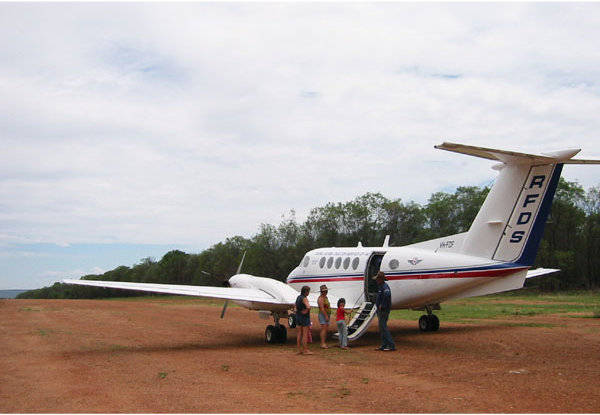
Beech KingAir
Statistics
According to the RFDS Australia Annual report 2015/16, the service owns 67 aircraft, and operates 23 bases with 1,225 employees. Every day, on average, on duty: travels 73,554 kilometers by air. In the heart of Australia in Alice Springs (100 kilometers north of the geometric center of the continent) there is a hospital for RFDS.
Science and technology
The European history of Australia was scientific from the very start. Australian science began with amateur naturalists collecting, describing, and classifying the unique flora and fauna that so amazed the earliest European explorers. It was as if another planet had been found. Buccaneer William Dampier, the first Englishman to tread on Australian soil (1688 and 1699), gathered some plant specimens (образцы) to take back home. His specimens are preserved in Oxford. Australian formal botany was thus born, 300 years ago.
Further expeditions by French scientists (Napoleon Bonaparte was keen on Australia’s flowers and marsupials) and, of course, by the English explorer Captain James Cook, were conceived (задуманы) as quests (поиски) for astronomical and biological discovery. Capt. James Cook’s first landfall (место высадки на берег) in 1770 was named Botany Bay to celebrate the large number of new plants discovered there. Initial efforts to acclimatize useful plants and animals, including the familiar flowers and birds of Britain, were followed by efforts to eradicate pests and weeds from pioneer farmlands.
Australia today maintains its place in the forefront (на переднем краю) of fields such as immunology, biotechnology, solar power, drug design, astronomy and astrophysics, plant biotechnology, solar engineering, nanotechnology and many other fields. Around 200 biotechnology companies operate in Australia – more per capita than in the United States.
Australia is a hub (центр) of expertise for its region. Many of its scientists are involved in South East Asia, pioneering studies of cereal crops (зерновые культуры), hydrology, solar energy and even the prediction of volcanic eruptions. Major programs linking Australia with China (fuel technology, genetics) and India (catalytic converters, astronomy) continue to flourish.
The Commonwealth Scientific and Industrial Research Organisation (CSIRO) began in 1926 as the federal government’s research agency.

Australia is one of the world’s key astronomical centers, thanks to its clear dry air, and clear wide view of the southern skies. The ingenious Mills Cross radio telescopes originated in Australia. The CSIRO’s radiophysics laboratory pioneered the use of the interferometer in 1946, while the 64-meter dish at Parkes, New South Wales, identified the first known quasars in 1960.
Australian medical innovations
In 1915 two Australians produced Aspro, a high-grade aspirin product that dominated the international market.

The first pain-relief pills were invented during the WWI
In 1926 a Sydney doctor invented the original heart pacemaker (кардиостимулятор).
In 1941 penicillin was extracted and refined by a team led by Australian Howard Florey. It went into production in time to aid casualties in the Second World War.
In 1928, the British scientist Alexander Fleming conducted an ordinary experiment in the course of studying the resistance of the human body to bacterial infections. He found that some staphylococcal culture colonies he left in laboratory cups were infected with a strain of the mold Penicillium Notatum. Around the mildew spots, Fleming noticed an area where there were no bacteria. This allowed him to conclude that the mold produces a bacteria-killing substance, which the scientist called “penicillin”.
Fleming underestimated his discovery, believing that it would be very difficult to get a cure. His work was continued by Oxford scientists Howard Florey and Ernst Cheyne. In 1940, they isolated the drug in its pure form and studied its therapeutic properties. On February 12, 1941, penicillin injection was given to a human for the first time. In 1945, Alexander Fleming, Howard Florey, and Ernst chain were awarded the Nobel Prize in physiology or medicine.
In 1961 two Australians built the first ultrasound scanner.
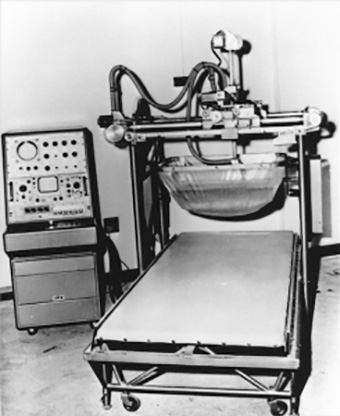
The first ultrasound scanner was designed 60 years ago
In 1979 Professor Graeme Clark invented an implant, designed to help the hearing-impaired and profoundly deaf.
Relenza, the world’s first anti-influenza drug, was developed in 1996 and approved for release in Australia in 2000. It is now sold in more than 51 countries.

In 1998 a team of scientists developed the Solar scan, which can quickly detect cancerous sunspots.

The Solar scan
Australia’s Nobel prizewinners
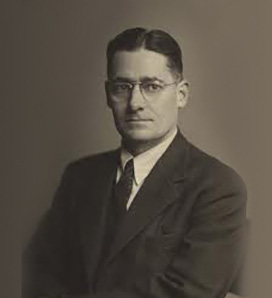
Lord Howard Walter Florey
Lord Howard Walter Florey (1898–1968) – British pathologist, born in Adelaide, Australia; professor at Oxford University 1935–62. With Ernst B. Chain isolated and purified penicillin for general clinical use (1939). Along with Alexander Fleming and Ernst B. Chain he was awarded the Nobel Prize in 1945 for the discovery of penicillin. Made life peer (1965).
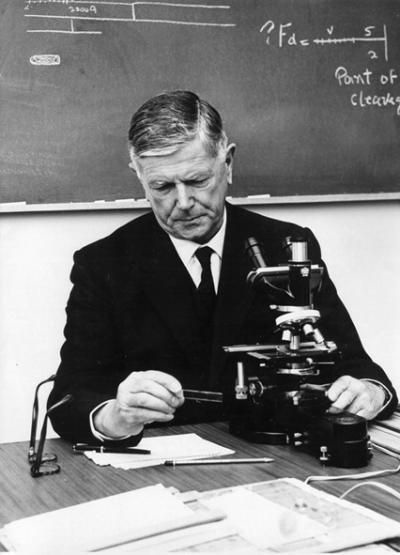
Sir Frank Macfarlane Burnet
Sir Frank Macfarlane Burnet (1899–1985) -- Contributor to knowledge about viruses. Was awarded the Nobel Prize in 1960 for his theory of immunological tolerance of transplanted tissues. This is the phenomenon in which, under certain conditions, the tissue of one animal can be successfully transplanted to another animal.
Burnet received many honors for his work. He was knighted (посвящен в рыцари) in 1951, appointed a Knight of the British Empire in 1969, and made a Knight of the Order of Australia in 1978.
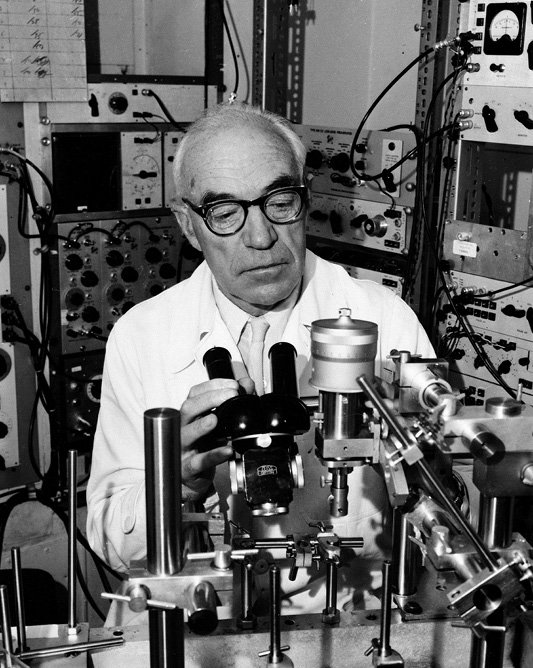
Sir John Carew Eccles
Sir John Carew Eccles (1903–1997) -- professor at Australian National University 1951–66. Along with British scientists Alan L. Hodgkin and Andrew F. Huxley he was awarded the Nobel Prize in 1963 for research on functions of nervous system and the brain work.

Sir William Lawrence Bragg
Sir William Lawrence Bragg and Sir William Henry Bragg, 1915. Awarded the prize in physics for their work analysing crystals using X-rays.

Sir John Warcup Cornforth
Sir John Warcup Cornforth, 1975. Awarded the prize in chemistry for work on the structure of living matter.

Professor Peter Doherty
Professor Peter Doherty, 1996. Awarded the prize in medicine for work on immunology.
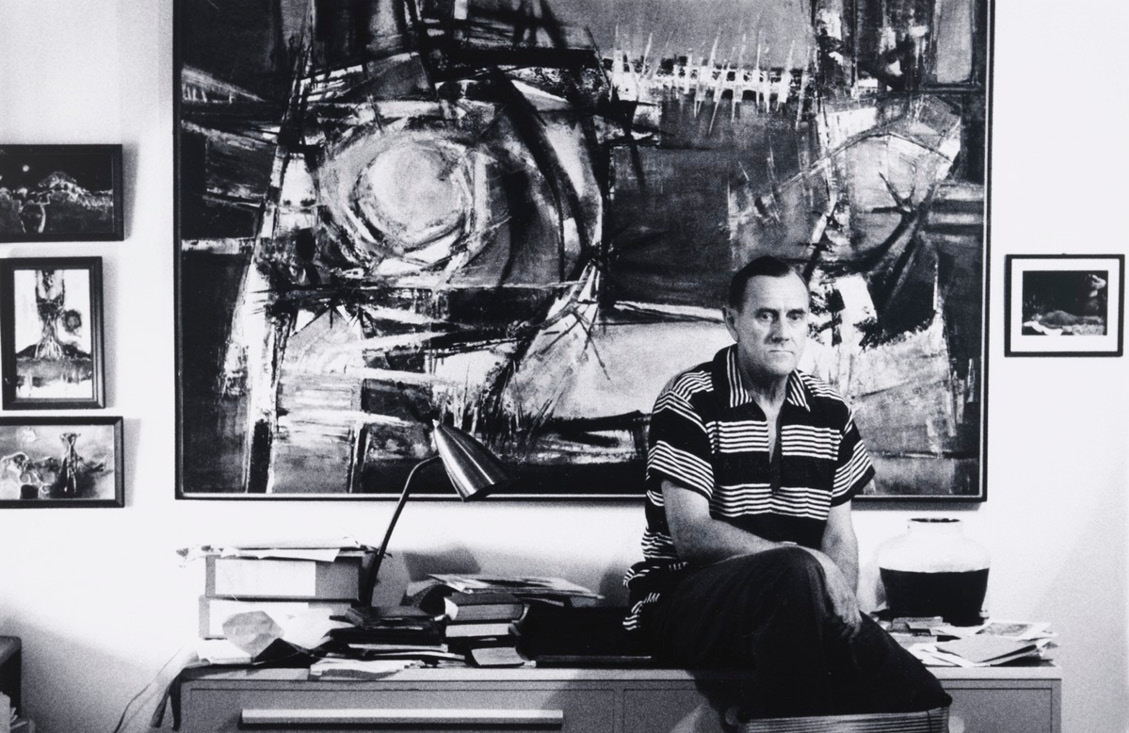
Patrick White
Patrick White, literature, 1973. Awarded the prize in literature for his epic works depicting Australian life.
Snapshots of Australian innovations
The “black box” («черный ящик» на самолете)
The first “black box” flight recorder was designed by David Warren of the Aeronautical Research Laboratories, Melbourne, in 1958. ‘The black box’ was of an orange colour, so it could be easily found in an abandoned area in the case of an accident.

Space pictures
In 1969, an Australian radio telescope in Parkes, New South Wales transmitted the first pictures of the moon landing to the world.

Radio telescope in Parkes, New South Wales
Polymer banknotes
Australia was the first country in the world to introduce polymer banknotes. In addition to their enhanced security, in Australia the notes last four times longer than the paper notes they replaced. At the end of their life they may be recycled for use in a variety of plastic products.
Nano-technology (нанотехнология)
In 1987, Australian scientists produced the world’s first nano-machine, a device so tiny that its parts are the size of molecules. The biosensor machine can be used to run medical checkups from within the body, analyse pollutants (загрязняющие вещества) or power minute (миниатюрные) computers.

A nano-machine in an electron microscope.
Future generations of nano-machinery promise to be even smaller.
Landmine (мины) detectors
Australia is leading the way in developing technology to detect unexploded ordnance (снаряды) and landmines. Minelab Electronics is an innovative electronics company based in Adelaide, South Australia that designs and develops metal-sensing technology. Minelab detectors are used by 44 countries around the globe as well as by the United Nations and other humanitarian organisations.

Ultrasound scans
Australians developed the ultrasound scanner (УЗИ) in 1961. The technology is used all around the world to detect the size, position and sex of an unborn child. This technology replaced harmful X-rays and delivers more accurate information about an unborn baby’s health.
Underwater computer
In 1993, the world’s first underwater computer was used to record data while conducting ocean research. It was invented by the Australian Institute of Marine Science.

Cold comfort
The most significant invention to come out of Australia is refrigeration. Although others had worked on the problem, the major breakthrough was made by James Harrison, a 36-year-old Scottish immigrant living in Geelung in Victoria. At the time of Harrison’s discovery in 1851, ice was used to keep food and drink cold, and in Australia most of it had to be imported. Blocks were cut from frozen ponds in the United States and sent by ships around Cape Horn.
Harrison was the publisher of the Geelung Advertiser and it was while cleaning type with ether (эфир) that he made his discovery. He noticed that as the ether evaporated it made the metal cold and realised that he could use this phenomenon (that gases cool as they expand, which was what was happening when the ether evaporated) to make ice. Harrison designed a machine that by 1857 was producing 3 tonnes of ice a day.
Unfortunately, people were reluctant to buy Harrison’s ice, claiming that they preferred the ‘natural’ product. He was declared bankrupt, and was forced to sell his newspaper in 1860. After his move to Melbourne, Harrison turned his attention to the problem of sending surplus Australian meat to Britain. Refrigeration was obviously the answer, and in 1873 Harrison arranged for a shipment of meat to be sent to England aboard the sailing ship Norfolk, fitted with his ether cooling system. The project ended in disaster. The meat was ruined for reasons beyond Harrison’s control, and he returned penniless to Britain to work as a journalist. It was to be another six years before Harrison’s dream was realised, and the first cargo of Australian frozen meat arrived safely in England using another refrigeration system.

First tank: good invention, bad timing
Shortly after the outbreak of World War I it became clear that a new type of fighting vehicle was needed to cope with the trenches, machine guns, barbed wire and mud.
In 1915, both France and Britain began experiments with tracked (на гусеничном ходу) armored (бронированный) fighting vehicles, which led to the appearance of the first tank, nicknamed “Mother”, in Britain in February 1916.
In fact, plans for a vehicle very similar to ‘Mother’ had been sent to the War Office in London by Adelaide engineer Lancelot de Mole in 1912. At that time, however, the War Office was unable to foresee a future for de Mole’s invention, and so it was rejected. After the war, de Mole put in a claim for royalties, but he had to be content with an acknowledgment from the British Royal Commission for Awards, which investigated his claims and recognised that he had produced a “… brilliant invention which anticipated, and in some respects surpassed that actually put into use in the year 1916”.

